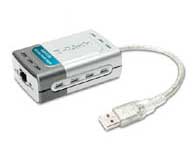Author: Roy Santos
Review Date: 12/22/2002

Model Number: DUB-E100 ($59)
For years, desktop systems have always turned to the PCI network adapter to connect. It has been the choice of network administrators and even home networking enthusiasts. It’s fast, cheap, and secure. Still, some balk at having to open their systems and thus opt for slower external network adapters whether wireless or attached to the Universal Serial Bus (USB) port.
USB 2.0 may change all of that. D-Link’s USB 2.0 Fast Ethernet Adapter delivers high transfer rates while ridding us of most installation pains.
It’s been a long time coming, but USB 2.0 is finally getting widespread deployment. Several companies are putting USB 2.0 products on the market and many new computers sport USB 2.0 ports. This next generation version of the Universal Serial Bus standard, also known as USB High Speed, promises throughput of up to 480 Mbps. It is compatible with slower USB 1.0 and 1.1 products, which produce a mere 1.5 and 12 Mbps throughput, respectively.
D-Link’s USB 2.0 Fast Ethernet Adapter should provide network administrators, both at home and at work, plenty of whip lashing transfer speeds without opening a single PC chassis.
Pros
- High throughput
- Easy USB 2.0 port installation
Cons:
- Older systems may need a USB 2.0 adapter
- Paltry warranty
BASIC FEATURES
The D-Link USB 2.0 Fast Ethernet Adapter provides the link between a USB 2.0-enabled machine and the Ethernet network. Only very new computers come equipped with USB 2.0 ports — many recent PCs don’t possess such a capability, in fact Windows XP is the only Microsoft OS with native support (older versions of Windows usually get drivers for USB 2.0 with any upgrade). The 2-GHz computer I used for testing was humbly equipped with mere USB 1.1 ports, so I had to install a USB 2.0 PCI adapter (the 2-Port DUB-A2, also from D-Link).
The Ethernet adapter comes with a USB 2.0-certified cable to connect it to a USB 2.0 port. The product itself is a silver and gray device about the size of a small pack of cards, sveltely shaped like the middle of a Coke bottle. It has dark gray, rounded side extensions, making the adapter look as if someone stuck a small hockey puck inside. The design lends an ergonomic feel to the device, though it’s hardly functional. Two green lights indicate a network link and network activity. An RJ-45 socket sits at the top, while a type-B USB connector can be found at the opposite end. D-Link offers a one-year limited warranty, miserly by today’s standards.
SETUP/INSTALLATION
If you already have USB 2.0 ports, installing the Ethernet adapter should be quick. As with many of its products, D-Link includes an illustrated quick installation guide that covers operating systems from Windows 98 to XP. The company duplicates the exact guide in the included CD, but not much else in the way of documentation or bigger-picture networking to clarify issues for the uninitiated networking newbie.
Upon connecting the Ethernet adapter to a USB 2.0 port, the PC detects it and asks for the drivers, which D-Link provides on the CD. This whole setup takes less than 5 minutes. Installing a USB 2.0 adapter in your PC beforehand will add anywhere from 5 to 30 minutes to the process, depending on how easy it is to get into your PC’s motherboard. It’s good to note, however, that the Ethernet adapter will also install on older USB ports, though you won’t get the fast transfer rates.
PERFORMANCE
The new network adapter produced pleasingly good results in my tests using NetIQ’s Qcheck. On average, the USB 2.0 Ethernet adapter managed to exceed 72 Mbps transfer speeds, an attractive number for those who perform large file transfers on their network. It easily overtakes the performance of many Fast Ethernet PCI network adapters. However, it’s turtle-like if you compare it to the almost 90 Mbps transfer speeds that some 10/100 PC Card network adapters could achieve. Still, if you factor in its excellent response times, the adapter should give users on your network plenty of time to do other tasks other than waiting for file transfers to finish.
SUMMARY
D-Link’s USB 2.0 Fast Ethernet Adapter should satisfy the needs of most low- to medium-traffic networks. If you don’t anticipate constant large file transfers and you have USB 2.0 on your PC, then this is a good external network adapter solution. With the right system, it’s relatively easy to install and provides decent throughput for most tasks.
If you have to install a USB 2.0 adapter, however, the ease of installation goes down a bit and the cost goes up a lot — but it extends your system’s capabilities overall. With a USB 2.0 hub, you can not only connect the network adapter, but many other USB or USB 2.0 devices as well.



